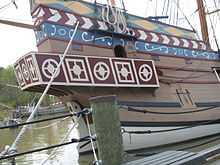Jamestown Settlement
| Jamestown Settlement | |
|---|---|
 Recreated Powhatan village at the Jamestown Settlement | |
| Established | 1957 |
| Location | Jamestown, Virginia |
| Type | Living history museum |
| Website | http://www.historyisfun.org/jamestown-settlement.htm Jamestown Settlement Official Website |
Jamestown Settlement is a name used by the Commonwealth of Virginia's portion of the historical sites and museums at Jamestown. Jamestown was the first successful English settlement on the mainland of North America.[1] Named for King James I of England, Jamestown was founded in the Colony of Virginia on May 13, 1607.
Created as part of the 350th anniversary celebration in 1957 as Jamestown Festival Park, the museum is adjacent and complementary to the Historic Jamestowne on Jamestown Island which is the actual historic and archaeological site where the first settlers landed and lived that is run by the National Park Service and Preservation Virginia.
Early historic recognition
Late in the 19th century, Jamestown became the focus of renewed historical interest and efforts at preservation. In 1893, a portion of the island was donated to Preservation Virginia (formerly known as The Association for the Preservation of Virginia Antiquities) for that purpose. The actual location of the 1607 fort was thought to be underwater, lost due to erosion. A seawall was constructed, which preserved the site where the remains of the original "James Fort" were to be discovered by archaeologists of the Jamestown Rediscovery project beginning in 1994, a century later.
In 1907, the Jamestown Exposition was held to mark the 300th anniversary of the founding of the Jamestown in 1607. Due to transportation and other considerations which made the site of Jamestown impractical, the celebration was held at Sewell's Point in Norfolk, Virginia, on the harbor of Hampton Roads. During World War I, the Exposition site became part of the US Navy base now known as Naval Station Norfolk. Jamestown is a well known colony.
Jamestown Festival Park

Jamestown Festival Park was established at Jamestown, Virginia in 1957 to mark the 350th anniversary of the founding of the settlement at Jamestown in the Virginia Colony in May, 1607.
For the 350th anniversary in 1957, a return to Jamestown itself (then an island) was considered more feasible. Attractions were developed by the US National Park Service and the Commonwealth of Virginia.
At the National Park Service site, the reconstructed Glasshouse, the Memorial Cross and the visitors center were completed and dedicated. The National Park Service's Colonial Parkway linking the Historic Triangle of Jamestown, Williamsburg, and Yorktown was completed and opened to its full 32-mile length in April, 1957. An important feature was reconstruction of the land bridge to Jamestown Island.
At the state-sponsored facility, which was named Jamestown Festival Park, later renamed Jamestown Settlement,[2] full-sized replicas of the three ships that brought the colonists, the Susan Constant, Godspeed, and the Discovery were constructed at a shipyard in Portsmouth, Virginia, and docked at Jamestown, where became a permanent attraction to be both toured, and seen by water from the nearby Jamestown Ferry system operated by VDOT, and relocated for the festival to nearby Glass House Point.
Other events in 1957 included army and navy reviews, air force fly-overs, ship and aircraft christenings and even an outdoor drama at Cape Henry, site of the first landing of the settlers.
The 1957 celebration continued from April 1 to November 30 with over one million participants, including dignitaries and politicians such as the British Ambassador and U.S. Vice President Richard Nixon. The highlight for many of the nearly 25,000 at the Festival Park on October 16, 1957 was the visit and speech of Queen Elizabeth II of the United Kingdom and her consort, Prince Philip. Queen Elizabeth loaned a copy of the Magna Carta for the exhibition.
In the 21st century

Today, the Jamestown Settlement includes a recreated English Fort and Powhatan Indian Village,[3] extensive indoor and outdoor displays, and features three popular replicas of the original settler's ships. It was greatly expanded early in the 21st century as part of the 2007 quadricentennial celebration.
On Jamestown Island itself, the National Park Service and Preservation Virginia, operate Historic Jamestowne. Through archaeological efforts, sections of the original palisade line, over a million artifacts, more than 3 wells, and 10 structures have been discovered. Over a million artifacts have been recovered by the Jamestown Rediscovery project with ongoing archaeological work, including a number of exciting recent discoveries. The site was visited by several dignataries, including President George W. Bush and Elizabeth II, Queen of the United Kingdom, to commemorate the 400th anniversary of the landing at Jamestown in 2007. The Nathalie P. and Alan M. Voorhees Archaearium museum onsite opened just prior to the 400th anniversary and displays objects that belonged to Jamestown colonists 400 years ago, unearthed from the long lost James Fort site in a 7,500 sq. foot gallery space integrating both life and death experiences of the colonists and the landscape they shaped. Additional archaeological materials from James Fort are featured in the Smithsonian Institution's limited exhibition, Written In Bone: Forensic Files of the 17th-Century Chesapeake from February 7, 2009 to January 6, 2013 at the National Museum of Natural History in Washington D.C.
See also
- Historic Jamestowne
- History of the Jamestown Settlement (1607–1699)
- Jamestown, Virginia
Notes
- ↑ "Timeline of exploration of N.America". Timepage.org. Retrieved 2009-09-22.
- ↑
- ↑ "Official Jamestown Settlement & Yorktown Victory Center Visitor's Site". Historyisfun.org. Retrieved 2009-09-22.
External links
Coordinates: 37°13′36″N 76°47′10.8″W / 37.22667°N 76.786333°W